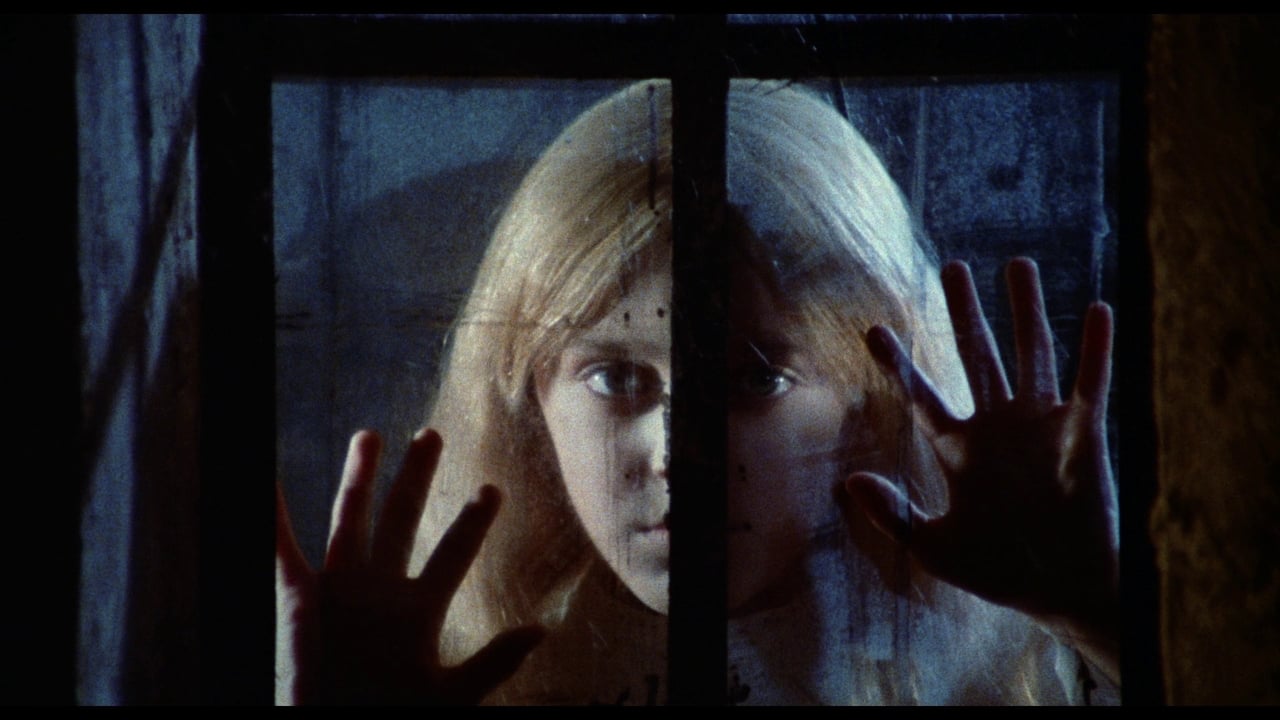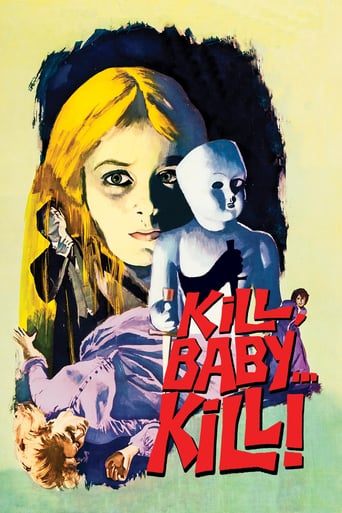Diagonaldi
Very well executed
Protraph
Lack of good storyline.
TrueHello
Fun premise, good actors, bad writing. This film seemed to have potential at the beginning but it quickly devolves into a trite action film. Ultimately it's very boring.
Ortiz
Excellent and certainly provocative... If nothing else, the film is a real conversation starter.
Scott LeBrun
The people of a late 19th century European village are beginning to perish in incidents that could be accidents, suicides...or murders. A dedicated police inspector, Kruger (Piero Lulli), investigates the case, while calling in a doctor from out of town. Dr. Paul Eswai (Giacomo Rossi Stuart) arrives to find a community full of frightened and deeply superstitious citizens, which frustrates the practical man of medicine. Dr. Paul even goes so far as to perform an autopsy on a young woman, a practice that these locals find to be abhorrent. In an odd touch, victims are found with gold coins placed inside their hearts.The relatively simple story actually isn't hard to follow at all, and in fact much crucial plot information is conveyed through pure exposition. Still, when this exposition is so vividly delivered by such an eclectic cast, it's hard to complain too much. Master of the macabre Mario Bava does go overboard with his frequent zooming in on people and then zooming back out. Other than that, this is an engaging example of the whole Gothic horror genre, with Bava working at the peak of his abilities. As he demonstrated so stylishly in previous efforts such as "Black Sunday" and "Black Sabbath", Bava was expert at creating an otherworldly atmosphere. He's capably assisted by his set decorator, Alessandro Dell'Orco, and cinematographer, Antonio Rinaldi. Bava also helped with the lighting, uncredited. Carlo Rustichellis' music is excellent, and the sound design is another plus, with that infernal giggling helping to put us on edge.The handsome Rossi Stuart is a jut jawed, stoic hero. Erika Blanc is beautiful and appealing as Monica Schuftan, who assists him with the autopsy. Gorgeous raven haired Fabienne Dali is intoxicating as Ruth, the local sorceress. Lulli, Luciano Catenacci, and Giovanna Galletti round out our interesting primary cast. One key casting decision is crucial in keeping the film somewhat off kilter.The finale is over awfully quickly, but there's still a fair bit to recommend here. The sequence that takes place about a quarter hour from the end is the most striking of all.Seven out of 10.
accattone74
Frequently lauded and cited as a strong influence by the likes of Martin Scorsese, Federico Fellini and David Lynch, Kill Baby, Kill is, along with the 1963 Bronte/Sade opus Whip & the Body, the most oft-mentioned crowning achievement of Mario Bava. Those who saw Kill Baby, Kill upon its initial release (as is the case with the three auteur mentioned above) witnessed something heretofore unseen in Italian Horror, if not in cinema as a whole. Never before had a low-budget, commercial and studio film been obviously and primarily concerned with its style, perhaps purposefully to the sacrifice of all else. The producers ran out of money two weeks into shooting, but Bava and the entire cast/crew decided to keep working for free. I'd like to think that this explains the film's aesthetic – the idea that the producers (out of shame for having no money) left the artists alone to do whatever they wanted. Who would they be to demand re-shoots with no money to pay anyone?And what style is this movie? Rural rococo? Barnyard baroque? Not since the heyday of Sternberg and Murnau had a film director been so obvious about his single-minded conveyance of artifice über alles. Ahem… I'd go so far as to call it The Scarlet Empress of Italian Horror. (Hopefully Marlene Dietrich and Jack Smith aren't rolling over in their graves from that one.) It's as if Bava were contractually obligated to tell a story or have a plot in this film (he's one of the three screenwriters on this one by the way), but all he really wanted to do was perfect using his purple and green fill lights, maybe show off his exquisite low-key techniques, and go zoom-shot reverse zoom-shot 'til one's head is spinning. Oh yeah, and that new industrial-sized dry ice machine – don't forget to leave that on full blast.The plot, which is amusingly influential in its own right, concerns the giggly, ball-bouncing ghost of an accidentally killed little girl who, through the vengeful psyche of her psychotic albeit medium mother, is terrorizing all the villagers into guilt-ridden suicide, one at a time. Though the mayor and his good-witch girlfriend-on-the-side are trying their best to outdo the nasty matron and her brat, all is so far for naught. All this is happening because the debauched and ignorant villagers were busy partying and sinning during an all-night drunken holiday, and they didn't notice that the girl (little Melissa), the Baroness Graps' daughter, was in danger. For poor Melissa got trampled by horses, and her attempt to call attention to her not-yet mortal wounds via the ringing of the town bell, fell upon gin-soaked eyes and ears. The mournful Baroness seeks revenge, and, with the help of her spectral spawn, her plan is succeeding nicely. Friday the 13th anyone…?The Villa Graps, where the delightfully paranoid Baroness resides, is (along with William Burroughs) a clear influence on Twin Peaks' Black Lodge, with the Baroness herself (as was pointed out to me by a Kill Baby, Kill obsessed friend) the undeniable source of Grace Zabriske's genius performance as Laura Palmer's mother. Like the Black Lodge, the Villa Graps is a maddening character in its own right. And as for the banal screenwriters of the already mentioned Friday the 13th, after seeing Kill Baby, Kill and Bava's later Twitch of the Death Nerve you too may wonder why a lawsuit was never filed against them. The stunning visuals, the beautiful tracking shots, the creepy laugh of Melissa, the Baroness' hair, the pure and absurd phantasmagoria of it all – Kill Baby, Kill is Bava's ultimate proof that style could attempt to be substance all by itself. And though he denied the identity of 'artist' his whole life (he preferred 'craftsman' or 'artisan'), with this film Bava proved that his instincts and impulses were in line with the greatest attribute an artist can ever hope to have: that of risk-taker.
Lee Eisenberg
It's easy to think of Italian cinema as exclusively Fellini or Visconti (both of whom definitely have their merits). But it's also worth knowing about Mario Bava, probably Italy's most renowned horror director. He directed a number of eerie movies in the giallo genre, among them 1966's Gothic "Operazione paura" ("Kill, Baby, Kill" in English). In this movie, a doctor goes to a Carpathian village to investigate a series of deaths. All of the victims have had coins embedded in them. The answer to the mystery lies beyond the grave.Martin Scorsese apparently considers this Bava's best movie. I don't know if I personally have a favorite Bava movie, but this one is certainly up there. There are of course a few cheap shocks, but two scenes really caught my eye. One is the scene looking down the staircase, which looks as if it's paying homage to Alfred Hitchcock's "Vertigo". But even more impressive is the scene where the doctor is repeatedly running through the same room. I assumed that he had ended up in some sort of existential hell (as in Jean-Paul Sartre's "No Exit"). A really neat trick.The characters themselves didn't come across as all that important. While watching the doctor, I kept thinking that he looked like Rod Taylor. Meanwhile, the main woman looked like Julie Christie, and the burgomaster looked like James Carville.All in all, a really fun movie. Grazie, Signor Bava!
Red-Barracuda
This colour-drenched Gothic horror film from Italian master Mario Bava is full to the brim with atmosphere and style. A doctor travels to a remote village to perform an autopsy on a woman who has died in mysterious circumstances. He immediately finds himself in the midst of a series of similar unexplained deaths. Everything seems to be connected to an ominous nearby house, the Villa Graps. While the malevolent ghost of little girl terrorises the vicinity…Kill, Baby…Kill! may sport a title that makes it sound like it should be a Russ Meyer sexploitation flick but to all intents and purposes this is pure Bava. It contains most of the elements that are associated with the great man's work: terrific fluid cinematography, beautiful use of colour and light, and strong atmospherics. It benefits too from a pretty good cast. Giacomo Rossi-Stuart is solid as the doctor while there is strong support from the beautiful and very Gothic Fabienne Dali as the local sorceress. Carlo Rustichelli pipes in too with a good score that sounds very like his soundtrack to Blood and Black Lace. But it also has an eerie section that accompanies the ghostly girl. This latter presence is well used throughout the picture. She appears in the night looking through windows, while her bouncing ball follows her around and adds splendid macabre detail - the ball led to the girl's death in the first place.Like all Bava films, this one is an exercise in cinematic style. Mostly, visual style. Many of the compositions are beautifully conceived and lit. Bava's camera gracefully captures it all and the sets are awash with striking colour and lit to perfection. In a couple of standout scenes the director puts together sequences of surreal splendour. One features a spiral staircase and the other has a man chase a figure through a maze of identical rooms until he finally catches him only to discover it is himself he has been chasing.Like many of Bava's films the story isn't really very great. Its serviceable and no more. But this is ultimately only a minor point as it's the style in which the story is told that is the main draw. And this is a great film from a master of visual cinematic style.

